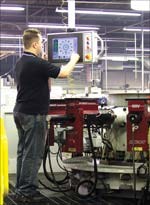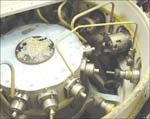Complex Parts Require A Quality Machine
With the help of a machine representative in the area, this shop decided to purchase a rotary transfer machine to be able to keep up with its high-volume production runs.
Frank Mari Sr., immigrated to the United States in 1971. He opened Frank's Welding & Manufacturing Company, Inc. 6 years later. The cornerstone of this philosophy is, "We will hit our deliveries, no excuses." Today, 28 years later, the company occupies 40,000 square feet, employs 70 people and does a lot more than welding (and still hits its deliveries). "We do a bit of everything," says Frank Mari, Jr., production engineer. "Our customers gradually wanted weldments machined and tapped, so we got into light machining. This led to CNC machining, then CNC turning and now to where we are today."
The shop currently runs 12 CNC VMCs (Haas and Miyano), a Mitsubishi 2512 LXP laser, a stable of about 11 CNC horizontal lathes and turning centers (Miyano, Daewoo and Kia) as well as the latest acquisition, a Hydromat Epic Rotary Transfer 45-12 that has 12 horizontal stations with the capacity to add up to six vertical stations. It also has a 0.8-second indexing time, accepts round, hex or square stock and can easily be converted to a blank loading machine.
The Epic was a thoroughly thought-through investment," Mr. Mari says. About 90 percent of the business is in CNC machining (the 10 percent remaining is in welding) and most of the work produces highly complex, close-tolerance electrical and hydraulic connectors. "We'll run jobs as small as 5,000 pieces per year up to 4 million pieces per year. And all of this is done on a just-in-time (JIT) delivery basis," he adds.
The Purchasing Decision
With the help of Arthur Machinery Inc., Hydromat's representative in the area, the decision to purchase the Epic was made to be able to keep up with the company's high-volume production runs. "On big jobs, I'll run the parts on a number of single-spindle machines for a short bit in order to get a jump on the job," he explains. "Then, when the part volume is ready, we shift the job from the single-spindle machines to the rotary transfer machine. It all happens pretty seamlessly. Then we break down the single-spindles for other work."
Another reason the shop decided to purchase this rotary transfer machine is that they needed to become more competitive in price on larger jobs. Mr. Mari noticed that the jobs producing 200,000 pieces and more, the company had to quote a per-hour labor rate on a single-spindle machine simply to be competitive. Some of these machines, he notes, require $4 to $5 an hour just to power up.
Mr. Mari did the math, and he figured he'd need seven or more single-spindle CNC machines to match the productivity of one Epic machine. That meant he'd need seven times the floor space, seven times the operators, seven times the maintenance, seven times the power and seven times the overhead, tooling, and so on. The obvious choice was to purchase the Epic. He adds that it can machine both large and small parts
The Electrical Connectors
Mr. Mari reports that the quality of the parts coming off this particular machine is exceptional. Unlike single-spindle machines, when the Epic warms up, the parts don't grow in length, and if the diameter changes at all, it is minimal 0.0002 inches or 0.0003 inches at the most. Also, repeatability is down in the range of hundredths of a thousandth of an inch.
"You won't find the connectors the company runs in Best Buy or Home Depot," he explains. "They are electrical connectors that might be used in large commercial or military satellite dishes, installed by professional technicians."
Typically, the connectors are expensive, as each is either silver or gold coated. These parts run from 0.500 inches to 2.500 inches in diameter and 1 inch to 3 inches in length. There may be as many as 15 to 20 operations on a single connector (eight or nine just on the ID), several deep ID grooves and a face groove or angle. The OD is generally hexagonal with slotting for a finger grip, and tolerances typically are ± 0.0015 inches on both diameter and length.
"These are very precise, critical parts," Mr. Mari says. "There can be no burrs on the front or end of the threads on these parts. So we single point the thread, and then with the threading tool, we chase it back as if we were using a turning tool. That cleans up burrs from the threads.
Programming
With the 12 stations on the Epic, Mr. Mari can basically do everything that a single-spindle machine can do with every unit running simultaneously. "I can do drilling, tapping, counterboring, ID grooving, OD profiling, single-point threading, and so on," he explains. Programming is very similar to programming a single-spindle CNC machine. The G codes and M codes are almost identical. It's like having 12 single-spindle CNC machines all on one base."
A user can program each station on the touchscreen from the machine pendant. For example, highlight station one, and the screen will show the different pages that can be accessed for a particular unit—the offset page, the program page and the diagnostic page. Then, the user can access the next unit, and so on.
Plus, all the units don't have to be in use, according to Mr. Mari. He cites an example where he was machining a fairly simple connector of 1.250 inches in diameter brass where he had to drill a hole, thread the ID and add an angle on the OD. He used only seven units and the others were turned off.
Another Rotary Transfer Machine?
Mr. Mari would definitely buy another Epic. He also points out that it's possible to upgrade units. "On our machine, we were budget conscious, and as a result, we have only three profiling units. But now, we're planning on trading in a single-axis unit and upgrading to another profiling unit, which will give us even more flexibility," he explains.
The bottom line, he says, is the proof is in the machine. "The programming is straight forward, the flexibility, productivity, repeatability and reliability is better than we anticipated. But if you don't start out with the best components and couple them with great engineering, then you've got no future."
Related Content
Precision Machining Technology Review: August 2024
Production Machining’s August 2024 technology showcase includes some of the latest technology from SW North America, Tsugami, Siemens, Select Manufacturing Technologies, Hurco and ECI Software Solutions — all on display at IMTS 2024.
Read MorePMTS 2023 Product Preview: High-Volume Turning
Learn about some of the latest high-volume turning solutions that will be on display at PMTS 2023.
Read MoreEdge Technologies Bar Feeder Provides Optimal Stock Support
The FMB Turbo RS 4-45 bar feeder provides reduced vibration, a boost to maximum rpm, better surface finishes and the ability to hold tighter tolerances.
Read MoreEdge Technologies Bar Feeding Solutions Support Range of Production Environments
IMTS 2024: Edge Technologies' product showcase includes a magazine feeder and short loader, as well as a bar feeder, pusher and separation system.
Read MoreRead Next
A Tooling Workshop Worth a Visit
Marubeni Citizen-Cincom’s tooling and accessory workshop offers a chance to learn more about ancillary devices that can boost machining efficiency and capability.
Read MoreDo You Have Single Points of Failure?
Plans need to be in place before a catastrophic event occurs.
Read More5 Aspects of PMTS I Appreciate
The three-day edition of the 2025 Precision Machining Technology Show kicks off at the start of April. I’ll be there, and here are some reasons why.
Read More











.jpg;maxWidth=300;quality=90)












